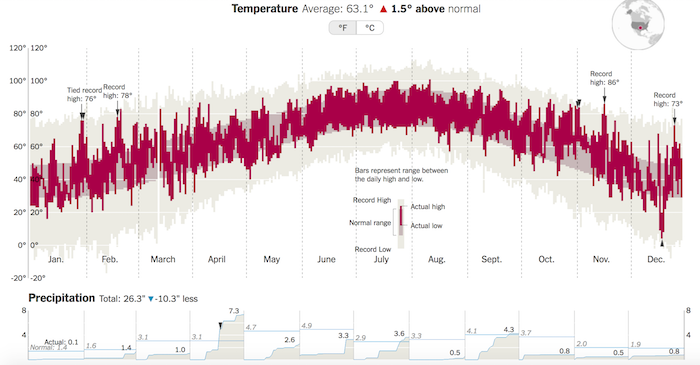Americans across the nation experienced 2016 as the hottest year on record and the third consecutive year to break the record, according to The New York Times.
The New York Times interactive radar showed Oklahoma City’s annual average temperature increased by 1.5 degrees Fahrenheit in 2016, and Guthrie’s average temperature increased by 3.8 degrees.
Steve Scovel, the executive director of facilities at Oklahoma Christian University, said the higher temperature affected the school by costing more money to provide air-conditioning than heat.
Scovel said despite varying temperatures throughout the year, some buildings on campus are cooled year round.
“There are some places that generate so much heat that we have to cool it all year,” Scovel said. “In the winter we run the small chiller instead of the bigger one. The effect of warm temperatures on campus is a double-edged sword. The heating bill goes down, as we are able to shut the boilers down, but our cooling bill goes up. So while our boilers won’t have to work as hard, there are some buildings that put a heavier burden on our 600-ton air conditioner. It’ll have to work harder on the warmer days in winter.”
Associate Professor of Chemistry Bill Luttrell said the increased, average global temperatures indicate global warming.
“Global warming is not a hoax,” Luttrell said. “Every year gets slightly warmer, and it may be one or two degrees, but globally that’s huge. It’s hard to say any given year that the weather we have at home is any indication of global warming. When you’re talking about climate change, it’s the whole globe. Next winter could be severe in Oklahoma, but still the overall effects of increasing temperatures are seen all over the world.”
Luttrell said the continued use of fossil fuels will result in long-term consequences.
“Nothing happens very fast, so it’s hard for us to pay attention,” Luttrell said. “But the weather is a lot more chaotic, with more intense storms and situations. Unfortunately, the United States is one of the highest consumers of energy. Eventually, it’s going to catch up to us. Some scientists believe there is a tipping point — a place we reach where we can’t go back. We are in trouble if we don’t transition to renewable energy sources.”
Scovel said he is not concerned about the impact of the gradual rise in temperature on the Oklahoma Christian campus at this time, but instead is worried about the opposite.
“Extreme temperatures are never good,” Scovel said. “The ideal temperature for what we do on campus is between 45 and 55 degrees. The weather that gives us the most problems is the cold in the winter. It’s hard on our systems and there’s the potential of having more problems if it’s sustained cold.”
According to Scovel, some buildings on the east side of campus have economizers designed to help save energy when cooling the buildings.
“When it’s between 45 and 55 degrees, then depending on how much activity is going on in the building, we can get free cooling,” Scovel said. “During these transitional times, instead of cooling the air, we open the economizer. It’s all automatic. We’re starting to implement those on campus in order to save energy. Fans don’t use much energy, it’s the compressors that use a lot.”
According to Luttrell, students can take a part in limiting global warming.
“As Christians, we have a responsibility to take care of God’s earth, and what that really means is taking care of it and of other people,” Luttrell said. “Some people don’t understand what climate change can mean to poor people. I think that’s what we, as Christians, should be thinking more about. We should try not to consume as much and downsize. It’s easier said than done.”












Be First to Comment